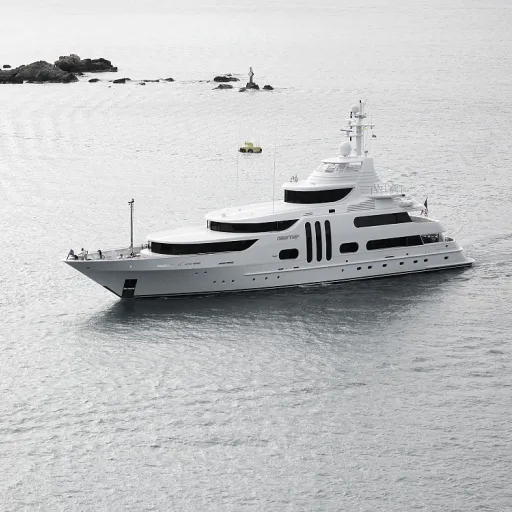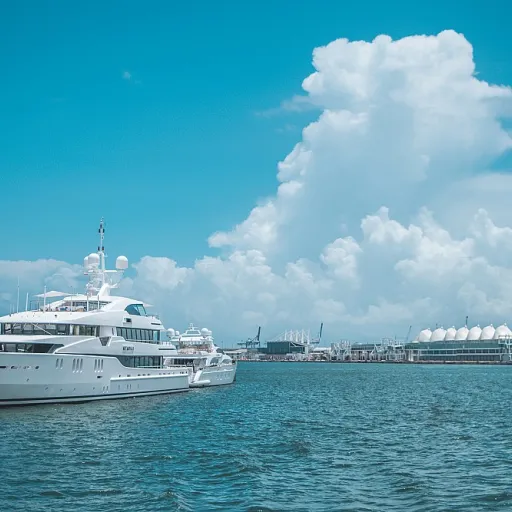-large-teaser.webp)
Understanding the significance of ensign sailing
The Heritage and Symbolism Behind the Ensign
For many yacht enthusiasts, the ensign is more than just a flag at the stern. It is a mark of tradition, identity, and pride. The ensign connects your boat to a broader community, whether you are part of a yacht club, a racing fleet, or a day sailing group. In the world of yachting, displaying the correct ensign is a sign of respect for maritime customs and a signal of your vessel’s nationality and registration.
The ensign’s significance is especially pronounced in the context of classic boats like those designed by Pearson Yachts. The unique features of catamaran hulls and the full keel of traditional day sailors both influence how and where the ensign is flown. For example, the left side of the stern is often reserved for the national ensign, while club burgees and class association flags have their own places.
Community, Competition, and Compliance
Within the ensign class, the flag is not just a symbol but a unifying element for sailors, sponsors, and race committees. Whether you are a member of a local yacht club or part of a larger class association, the ensign helps identify your boat during regattas and day sailing events. It is also a practical tool for the race committee to distinguish between fleets and classes, especially in close strategic and tactical racing scenarios.
Many yacht owners use the club’s website or library to stay updated on ensign regulations and best practices. The shopping cart feature on class association sites even allows sailors to buy ensign flags, ensign spars, and accessories for their boats. Member login areas often provide exclusive resources, such as hall of fame listings and tips for proper ensign display.
Why the Ensign Matters Today
As the role of the ensign evolves in modern yachting, its core purpose remains unchanged: to represent the boat’s heritage, compliance, and connection to the wider sailing community. Whether you are a day sailor, a racer, or a cruising enthusiast, understanding the significance of the ensign is essential for anyone passionate about yachts and the traditions that define them along the coast of the United States and beyond.
Navigating international waters and ensign regulations
International Waters: Where Ensign Rules Matter
When sailing beyond your home coast, understanding ensign regulations becomes essential. The ensign is more than a decorative flag; it’s a legal mark of your yacht’s nationality and compliance. In international waters, the correct display of your ensign signals to other boats, race committees, and authorities that your vessel adheres to the standards of its home country. This is especially important for members of a yacht club or class association, as improper display can lead to confusion or even fines.Key Regulations Every Yacht Owner Should Know
Ensign rules can vary by country and even by yacht club. Here are some core points to keep in mind:- Always fly your ensign from the left side (port) or at the stern, as per tradition and regulation.
- Day sailing or racing? The ensign must be visible, especially during official events or when passing race committee boats.
- Some countries require a sponsor or club membership to fly specific ensigns, particularly for class boats like the Ensign class or Pearson yachts.
- When entering foreign ports, lower your ensign and raise a courtesy flag of the host nation, but keep your ensign displayed as well.
Compliance and the Modern Yacht Fleet
The rise of international regattas and day sailor events means that yacht owners must stay updated on ensign regulations. The class association or yacht club often provides guidance, but it’s wise to consult the official website or library of maritime rules before setting out. For those with classic designs, like full keel boats or Carl Alberg-inspired hulls, maintaining traditional ensign etiquette is part of the heritage.Why Proper Ensign Use Matters for the Community
Correct ensign handling isn’t just about following rules—it’s about respect for the fleet, the race committee, and the broader sailing community. Whether you’re a member login user on your club’s website, shopping cart in hand to buy ensign gear, or a day sailor enjoying the coast, your ensign is a symbol of pride and connection. For more on how yachting impacts your experience on and off the water, check out this article on how yachting enhances mental well-being.Staying Strategic and Tactical
Navigating ensign regulations is a close strategic game. From roller furler setups to ensign spars, every detail counts. Stay informed, consult your club’s library, and remember: the right ensign, flown correctly, marks you as a true sailor ensign in the hall of fame of yachting.Selecting the right ensign for your yacht
Key factors in choosing your yacht’s ensign
Selecting the right ensign for your yacht is more than a matter of tradition—it’s a crucial part of your vessel’s identity and compliance. The ensign you fly signals your yacht’s nationality, class association, and even your commitment to the broader sailing community. Whether you’re day sailing along the coast or participating in a racing fleet, the choice of ensign can influence your experience and reputation on the water.
- Legal compliance: Your ensign must align with the regulations of the country where your yacht is registered. This is especially important when navigating international waters, as improper display can result in fines or detainment by a race committee or coast guard.
- Class and club affiliation: Many yacht clubs and class associations, such as the Ensign Class Association, have specific requirements for ensign design and display. Flying the correct ensign marks your participation in a recognized fleet and can enhance camaraderie during regattas or day sailing events.
- Design and tradition: Classic boats, like those designed by Pearson Yachts, often favor traditional ensign designs that reflect their heritage. For full keel day sailors or those with roller furlers, the right ensign can be a nod to the hall of fame legacy of designers like Carl Alberg, even if you’re not racing.
- Practical considerations: Consider the size and placement of your ensign. It should be visible from the left side and not interfere with sailing operations. Some sailors opt for ensign spars for a clean, professional look, especially when racing or hosting a sponsor event.
Resources for making the right choice
Many yacht owners turn to their club’s library or class association website for guidance. These resources often provide detailed information on ensign regulations, approved designs, and even a shopping cart to buy ensign flags or accessories. Member login features can give you access to exclusive content, such as strategic tactical advice for racing or tips on day sailor etiquette.
For those interested in exploring how vibrant yacht club communities influence ensign selection and display, this article on the Buckeye Lake Yacht Club community offers valuable insights into the role of tradition and camaraderie in modern yachting.
Ultimately, the right ensign is a mark of respect for both the rules and the rich history of sailing. Whether you’re a seasoned sailor ensign or new to the fleet, making an informed choice ensures your yacht stands out for all the right reasons.
Challenges faced by yacht owners in ensign compliance
Common Compliance Hurdles for Yacht Owners
Yacht owners often find that ensign compliance is more complex than it first appears. While the ensign is a proud symbol of a yacht’s identity and heritage, it also comes with a set of legal and practical challenges. These issues can affect everything from day sailing to international racing, and even the simple act of joining a yacht club or class association.
- Regulatory Variations: Different countries and even local coast authorities have their own rules about which ensign can be flown, how it must be displayed, and when it should be raised or lowered. For example, a boat registered in the United States may face different requirements when entering foreign waters, especially during international fleet events or regattas.
- Class and Club Requirements: Many yacht clubs and class associations, such as the ensign class or those dedicated to pearson yachts, have their own traditions and rules regarding ensign display. Compliance with these can be essential for participation in club events, day sailing, or racing. The race committee may even inspect ensign handling before allowing a boat to compete.
- Design and Equipment Limitations: The design of certain boats, especially classic full keel models or day sailors, can make it tricky to mount and fly an ensign properly. Owners may need to invest in specialized ensign spars or roller furlers to ensure their flag is both visible and secure, without interfering with sailing performance or safety.
- Documentation and Proof: Some events or clubs require proof of ensign compliance, such as registration documents or sponsor approval. This can involve navigating club websites, member login portals, or even a shopping cart system to buy ensign accessories or official flags.
Strategic and Tactical Considerations
Beyond legalities, there’s a close strategic aspect to ensign display. In competitive racing, the proper use of an ensign can mark a boat’s class or sponsor, signaling affiliation to the fleet and race committee. Missteps here can lead to disqualification or disputes, especially in high-profile events or hall of fame regattas. For day sailing, a well-chosen ensign enhances the boat’s presence and signals respect for tradition, which is valued by both peers and club committees.
Owners are encouraged to consult their class association’s library or website for up-to-date guidance. Staying informed is key, as regulations and best practices continue to evolve with the modern yachting landscape.
The evolving role of ensigns in modern yachting
The shifting meaning of ensigns in today’s yachting culture
In the past, the ensign was a straightforward marker of nationality and compliance for yachts and boats. Today, its role has expanded and evolved, reflecting changes in yacht design, international sailing regulations, and the expectations of both yacht owners and clubs. The ensign is now more than a legal requirement—it’s a symbol of identity, tradition, and even sponsorship within the yacht community.
- Identity and tradition: Yacht clubs and class associations use the ensign to mark their fleet, celebrate their history, and foster a sense of belonging. For example, the ensign class and pearson yachts have their own traditions, often highlighted during day sailing events and regattas.
- Modern compliance: As regulations shift, especially for those navigating international waters or racing, the ensign has become a key part of strategic and tactical planning. Race committees and club officials now pay close attention to proper ensign display, ensuring every boat meets the mark for both local and international standards.
- Branding and sponsorship: The ensign can also serve as a platform for sponsors, with some fleets incorporating sponsor logos or colors into their design. This trend is particularly visible in high-profile races and among boats with significant backing.
Technological advances have also influenced how ensigns are produced and displayed. Roller furlers, full keel designs, and other innovations in yacht hardware have made it easier to handle and showcase the ensign, even during close strategic maneuvers. Online resources, such as the class association website or yacht club library, offer guidance on ensign handling, member login for updates, and even a shopping cart to buy ensign-related gear.
For day sailors and those interested in the hall of fame or buying an ensign, the evolving role of the ensign is clear: it’s a blend of tradition, compliance, and modern yachting culture. Whether you’re racing along the coast, joining a new fleet, or simply enjoying a day on the water, the ensign remains a vital part of the yachting experience.
Expert tips for proper ensign handling and display
Best Practices for Displaying Your Ensign
Proper ensign handling is a mark of respect for both tradition and regulation in the yacht world. Whether you are day sailing along the coast or participating in a racing fleet, following best practices ensures your boat stands out for the right reasons.- Always hoist the ensign at the stern, typically on the left side when viewed from the rear. This is the recognized position for yachts in the United States and is respected by yacht clubs and race committees alike.
- Ensure your ensign is clean, undamaged, and proportional to your boat’s design. A faded or torn ensign can reflect poorly on both the sailor and the club.
- Lower the ensign at sunset or when leaving the boat unattended for the day. This tradition is still observed by many class associations and is often enforced during regattas.
- When racing, check the race committee’s instructions. Some fleets require the ensign to be removed during competition, while others allow it to remain as a mark of club pride.
- For boats equipped with a roller furler or ensign spars, make sure the flag is securely fastened and does not interfere with sailing operations or safety equipment.
Strategic and Tactical Considerations
Displaying your ensign is not just about compliance. It can also be a close strategic move, especially in events where club affiliation or class membership is significant. The ensign class, for example, has a strong tradition of using the flag to signal unity and sportsmanship among sailors.- During fleet events, a well-presented ensign can help the race committee and sponsors identify your boat quickly, especially in large regattas or when entering the hall of fame for your class.
- For day sailors and those in the full keel category, the ensign is a subtle way to connect with the broader community, from the library of class association resources to the shopping cart on the official website where you can buy ensign accessories.













